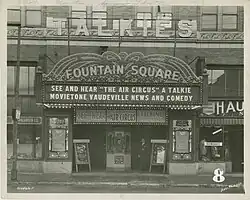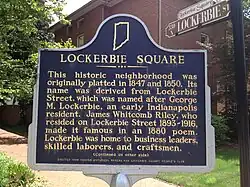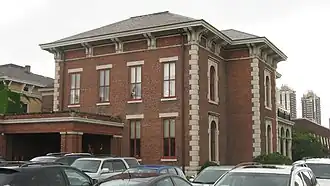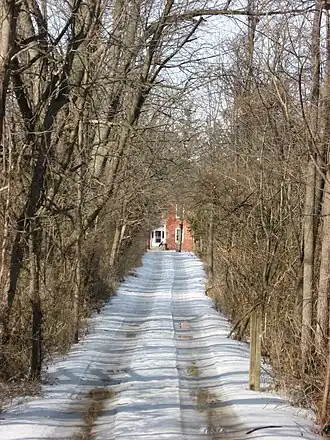Indianapolis Historic Preservation Commission
| Abbreviation | IHPC |
|---|---|
| Formation | 1967 |
| Headquarters | (Temporarily) 2042, City-County Building, 200 E. Washington Street, Indianapolis, IN 46204 |
| Location |
|
President | William A. Browne, Jr. |
Vice President | David L. Baker |
| Annie Lear, Disa Watson-Summers, Michael Bivens, Anson Keller, Anjanette Sivilich RA, Krystin Wiggs | |
| Website | https://www.indy.gov/agency/indianapolis-historic-preservation-commission |
The Indianapolis Historic Preservation Commission (IHPC) is responsible for preserving historic areas and structures in Marion County, Indiana, United States.[1][2] It oversees the exteriors of historic landmarks, such as ensuring that walls, light fixtures, roofing, etc., are stable and appropriate. Citizens of Indianapolis can apply to have the commission review and fix historic structures by applying for a certificate of appropriateness. The commission was established in 1967. It has a collection in the Indiana University Indianapolis library of digitized images of historically significant areas.[3] The IHPC currently oversees 13 historic districts and 5 conservation areas.[1]
History
In 1967, the IHPC was established by the state of Indiana. It currently holds 9 voting members, as well as 2 non-voting members, who all decide what will and will not be protected under the commission.
Historic Districts
- Chatham–Arch and Massachusetts Avenue collectively anchor downtown Indianapolis's northeast side. Chatham–Arch is a residential neighborhood on the National Register of Historic Places. Walking tours of the area are available.[4][5] Massachusetts Ave. is a commercial corridor geared towards artistry, home to multiple art galleries, jazz clubs, and vintage shops. It's seen as a key cultural spot for this presence of art as well as its architectural design.[6][7][8]
- Fletcher Place is a neighborhood named after Calvin Fletcher Sr, one of the first residents.[9] The Fletcher Place Community Center was a key part of the neighborhood, supporting local families through assistance with education, finances, and food since the Great Depression.[10]

Fountain Square Theatre marquee - Fountain Square is a neighborhood near downtown, known for its art. Historically it was a business and entertainment district, with several movie theaters, and is now an active hub for vintage and antique stores, book shops, art shows and stores, and nightlife.[11]
- Herron–Morton Place is a neighborhood whose site was originally owned by the Indiana State Board of Agriculture and served as the site of the Indiana State Fair. During the Civil War, it was used as a training grounds for Union troops and then as POW camp for Confederate soldiers. The southern portion of the area was the home to an art museum and school.[12]
- Indiana World War Memorial Plaza contains the "Soldiers and Sailors" statue as well as a War Memorial Museum and University Park. It was originally created for WWI veterans, and has been expanded to all Indiana veterans. It was named a National Historic Landmark in 1994.[13][14]

A plaque explaining the history of Lockerbie Square - Irvington Historic District is one of the first planned suburbs in Indianapolis and has a Romantic architecture style. It was the previous site of Butler University and was known for its art, education, and vehicle access. It is now known for its large annual Halloween festival.[15][16]
- Lockefield Gardens, located near the IU campus in downtown Indianapolis, is a former 1930s housing project, the first of Indianapolis and designed by William Earl Russ.[17] It is an African American cultural area as well, due to it being an affordable area for Black families to move into and form communities.[18]
- Lockerbie Square is the oldest residential neighborhood in Indianapolis.[19] It contains the James Whitcomb Riley Museum Home, which preserves the architecture and furnishings of the home of local poet James Whitcomb Riley. Lockerbie was the name of Riley's dog.[20]
- Monument Circle, also known as the Soldiers' and Sailors' Monument, is the center or "heart" of Circle City. Recently, a temporary park was added to provide more accessible public spaces to the city.[21][22]

An image of the Indiana War Memorial at dusk - Old Northside is a residential Indianapolis neighborhood that was named a historic district in 1978,The community was considered fashionable in the late 19th century, with many high-profile people living there, but from World War I to until the 1970s it saw a steady decline in people and activity.[23][24] Efforts have been made to refurbish the houses in the neighborhood.[25]
- St. Joseph Historic Neighborhood has a significant number of architectural styles from the Civil War era and before.[26] The neighborhood's buildings have 15 different styles of architecture, including Italianate, Greek Revival, and Queen Anne.[27]

The Bals–Wocher House - Wholesale District was a key distribution hub due to presence of the Indianapolis Union Station.[28] It is named after the wholesale businesses formerly and currently located there.[29]
- Woodruff Place is one of the original suburbs of Indianapolis, with three esplanades that separate the west, middle, and east drives of the neighborhood. It was remained an independent town until 1962, when it was annexed by the city of Indianapolis.[30][31]
Conservation Areas
- Cottage Home Historical District was less of a neighborhood, including residential areas but also many work and shopping centers. It included a large German-American demographic as well as Irish-American and African-American.[32]

A pink Victorian house in Cottage Home Historical District, circa 1990 - Cumberland is another district with multiple parks and hiking trails, providing natural spaces and conservation areas. It was annexed in 1968.[33][34]
- Fayette Street Conservation Area is associated with both older black neighborhoods and the canal/white river. As such, it is considered a Water Landmark.[35][36]
- New Augusta is a district that contains houses, shopping centers, and schools. It is a part of Pike Township, and focuses its efforts towards preserving and conserving a historic community.[37][38]
- Ransom Place is a neighborhood that, in working with Keep Indianapolis Beautiful (KIBI), developed a park containing native plants and trees. The Ransom Place Neighborhood Association (RPNA) was founded to support preservation.[39][40]
Protected Properties
- Askren House is a building originally housing the family of John Thomas Askren, of whom began building in 1828 and finished in1850. The building now houses a dinner club, called Askern House Dinner Club, run by an Indiana chef.[41]

Thomas Askren House driveway in winter - The Church of the Holy Cross, Rectory, Gymnasium & School Building began as a school and slowly transitioned into a multi-purpose building over the years. It was built in 1896, and became fully formed by the 1980s before being shut down in 2014. Demolition has been discussed but, as of 2024, nothing has come of it.[42][43][44]
- The Drake Apartments were luxury apartments established in 1929. In 2023, it was purchased by the State of Indianapolis from the Children's Museum of Indianapolis for 1.02 million dollars, with votes from the IHPC. The goal is/was to turn them into modern, affordable apartments for Indiana citizens.[45][46][47]
- Oldfields-Lilly House & Gardens, or Eli Lilly House, is owned by the Newfields museum, or the Indianapolis Museum of Art (IMA). It was built in 1912, with expansive gardens and fountains, as well as a 22-room, 2 story manor, being 52-acres in total. The house was purchased by the Lilly family in 1932, and given to the Indianapolis Art Association in 1967.[48][49][50]

Front of The Gramse, located at 2203 Broadway Street - The Gramse or The Nicholson Historical Apartment, a bungalow built in 1915, was a historic apartment building, and is currently on track to become renovated, affordable housing. It was placed on the National Register of Historic Places in 2011.[51][52]
- Hannah-Oehler-Elder-House is a "haunted" house located on Madison Avenue, claimed as such due to the death of the original owner, Alexander Hannah, and his wife. It was then purchased by Roman Oehler and inherited by his daughter, Romena Oehler-Elder, who got it placed on the National Register of Historic Places in 1978. As a public property, a group called the Paranormal Meet and Greet has been meeting there since 2008.[53][54]
- Hilbert Circle Theater is where the Indiana Symphony Orchestra performs, in monument circle in downtown Indianapolis. It is the second-oldest building in the area, having opened for business in 1916 as the Circle Theatre and renovated a few times since, in the 1930s, 1980s, and being renamed in 1996.[55][56]
- Hollingsworth House is a historic Indiana home built in 1954
- Pierson-Griffiths House, also known as Kemper House,
- Meridian Street Methodist Episcopal Church
- Morris Butler House
- Old City Hall
- P.R. Mallory Company Factory was built in1924 and founded by namesake Philip Rogers Mallory.
- Ruskaup-Ratcliffe House and Store is a building within the Cottage Home Historical District.
- Union Station Grand Hall
See also
- Indianapolis Cultural Districts
- Indiana Historical Society
- National Register of Historic Places listings in Marion County, Indiana
References
- ^ a b Indianapolis, Encyclopedia of (July 12, 2021). "Indianapolis Historic Preservation Commission". Encyclopedia of Indianapolis. Retrieved June 16, 2025.
- ^ "Indianapolis Historic Preservation Commission". herron-morton.com. Retrieved June 23, 2025.
- ^ "Indianapolis Historic Preservation Commission | University Library". library.indianapolis.iu.edu. Retrieved June 16, 2025.
- ^ "Chatham Arch Neighborhood Walking Tour". Indiana Landmarks. Retrieved July 7, 2025.
- ^ "National Register Digital Assets". National Register of Historic Places. March 13, 1980. Retrieved July 7, 2025.
- ^ "Mass Ave | Historic Urban Neighborhoods of Indianapolis". huniindy.org. Retrieved July 10, 2025.
- ^ Indianapolis, Encyclopedia of (April 25, 2021). "Massachusetts Avenue". Encyclopedia of Indianapolis. Retrieved July 10, 2025.
- ^ "Arch at Chatham | Downtown Indianapolis". downtownindy.org. Retrieved July 10, 2025.
- ^ Indianapolis, Encyclopedia of (April 25, 2021). "Fletcher Place". Encyclopedia of Indianapolis. Retrieved July 1, 2025.
- ^ "Fletcher Place Community Center | Indianapolis, Indiana". fletcherplacecc.org. Retrieved July 1, 2025.
- ^ Indianapolis, Encyclopedia of (April 25, 2021). "Fountain Square". Encyclopedia of Indianapolis. Retrieved July 7, 2025.
- ^ "Herron-Morton | Historic Urban Neighborhoods of Indianapolis". huniindy.org. Retrieved July 8, 2025.
- ^ Indianapolis, Encyclopedia of (March 27, 2021). "Indiana World War Memorial Plaza". Encyclopedia of Indianapolis. Retrieved July 14, 2025.
- ^ "National Historic Landmark Nomination". National Historic Landmark Registry. Retrieved July 14, 2025.
- ^ Indianapolis, Encyclopedia of (April 25, 2021). "Irvington". Encyclopedia of Indianapolis. Retrieved July 10, 2025.
- ^ "Indianapolis-Irvington Neighborhood, Indiana | Advisory Council on Historic Preservation". www.achp.gov. Retrieved July 10, 2025.
- ^ Campbell, Steve (March 10, 2014). "What's in a Name: Lockefield Gardens | Historic Indianapolis | All Things Indianapolis History". Historic Indianapolis. Retrieved July 7, 2025.
- ^ Indianapolis, Encyclopedia of (April 26, 2021). "Lockefield Gardens". Encyclopedia of Indianapolis. Retrieved July 7, 2025.
- ^ "Lockerbie Square People's Club". Lockerbie Square. Retrieved July 1, 2025.
- ^ Indianapolis, Encyclopedia of (July 12, 2021). "Indianapolis Historic Preservation Commission". Encyclopedia of Indianapolis. Retrieved July 1, 2025.
- ^ "Monument Circle Park". Merritt Chase. Retrieved July 10, 2025.
- ^ Indianapolis, Encyclopedia of (March 27, 2021). "Monument Circle". Encyclopedia of Indianapolis. Retrieved July 10, 2025.
- ^ "Old Northside | Historic Urban Neighborhoods of Indianapolis". huniindy.org. Retrieved July 1, 2025.
- ^ "Old Northside Neighborhood Walking Tour". Indiana Landmarks. Retrieved July 1, 2025.
- ^ Cierzniak, Libby (September 7, 2013). "Indianapolis Collected: The Fall and Rise of the Old Northside | Historic Indianapolis | All Things Indianapolis History". Historic Indianapolis. Retrieved July 1, 2025.
- ^ "St. Joseph | Historic Urban Neighborhoods of Indianapolis". huniindy.org. Retrieved July 8, 2025.
- ^ Indianapolis, Encyclopedia of (May 8, 2021). "St. Joseph". Encyclopedia of Indianapolis. Retrieved July 8, 2025.
- ^ Indianapolis, Encyclopedia of (March 27, 2021). "Wholesale District". Encyclopedia of Indianapolis. Retrieved July 8, 2025.
- ^ "The Wholesale District in Downtown Indianapolis". www.livinginindianapolis.com. June 19, 2025. Retrieved July 8, 2025.
- ^ "Woodruff Place | Historic Urban Neighborhoods of Indianapolis". huniindy.org. Retrieved July 8, 2025.
- ^ Indianapolis, Encyclopedia of (June 21, 2021). "Woodruff Place". Encyclopedia of Indianapolis. Retrieved July 8, 2025.
- ^ Indianapolis, Encyclopedia of (April 25, 2021). "Cottage Home". Encyclopedia of Indianapolis. Retrieved July 17, 2025.
- ^ Indianapolis, Encyclopedia of (April 25, 2021). "Cumberland". Encyclopedia of Indianapolis. Retrieved July 15, 2025.
- ^ "Cumberland, IN". www.town.cumberland.in.us. Retrieved July 15, 2025.
- ^ "Fayette Street | Historic Urban Neighborhoods of Indianapolis". huniindy.org. Retrieved July 17, 2025.
- ^ Indianapolis, Encyclopedia of (June 21, 2021). "Fayette Street". Encyclopedia of Indianapolis. Retrieved July 17, 2025.
- ^ Freeland, Sharon Butsch (September 30, 2014). "HI Mailbag: New Augusta | Historic Indianapolis | All Things Indianapolis History". Historic Indianapolis. Retrieved July 15, 2025.
- ^ Indianapolis, Encyclopedia of (April 26, 2021). "New Augusta". Encyclopedia of Indianapolis. Retrieved July 15, 2025.
- ^ "Ransom Place". Indy Parks & Recreation. Retrieved July 15, 2025.
- ^ Indianapolis, Encyclopedia of (January 5, 2022). "Ransom Place". Encyclopedia of Indianapolis. Retrieved July 15, 2025.
- ^ Hamlett, Ryan (December 10, 2013). "The Thomas Askren House | Historic Indianapolis | All Things Indianapolis History". Historic Indianapolis. Retrieved August 14, 2025.
- ^ Indianapolis, Encyclopedia of (April 25, 2021). "Holy Cross". Encyclopedia of Indianapolis. Retrieved August 14, 2025.
- ^ "The Church of the Holy Cross - 1401 East Ohio Street - Holy Cross Neighborhood - PocketSights". pocketsights.com. Retrieved August 14, 2025.
- ^ Simmons, Taj (March 27, 2024). "Archdiocese of Indianapolis intends to demolish Church of the Holy Cross". WRTV Indianapolis. Retrieved August 14, 2025.
- ^ "Indianapolis purchases Drake Apartments from Children's Museum for $1.02M". The Indianapolis Star. Retrieved August 18, 2025.
- ^ "The Indianapolis Star Subscription Offers, Specials, and Discounts". subscribe.indystar.com. Retrieved August 18, 2025.
- ^ Sheridan, Jill (January 24, 2021). "The Future Of Drake Building Unknown". WFYI Public Media. Retrieved August 18, 2025.
- ^ "Lilly House". discovernewfields.org. Retrieved August 18, 2025.
- ^ Lorentz, Lisa (January 24, 2014). "Friday Favorite: Oldfields | Historic Indianapolis | All Things Indianapolis History". Historic Indianapolis. Retrieved August 18, 2025.
- ^ "Oldfields - Lilly House & Gardens at Newfields | TCLF". www.tclf.org. Retrieved August 18, 2025.
- ^ admin (November 9, 2017). "Keeping historic homes affordable in Indianapolis' King Park Neighborhoods". IFF. Retrieved August 19, 2025.
- ^ "National Register of Historic Places 2011 Weekly Lists" (PDF). National Park Service. December 30, 2011. Retrieved August 19, 2025.
{{cite web}}: CS1 maint: url-status (link) - ^ Campbell, Steve (May 5, 2014). "What's in a Name - The Hannah-Oehler-Elder House | Historic Indianapolis | All Things Indianapolis History". Historic Indianapolis. Retrieved August 19, 2025.
- ^ Indianapolis, Encyclopedia of (May 11, 2023). "Hannah House". Encyclopedia of Indianapolis. Retrieved August 19, 2025.
- ^ "Hilbert Circle Theatre | Downtown Indianapolis". downtownindy.org. Retrieved August 19, 2025.
- ^ Indianapolis, Encyclopedia of (March 9, 2021). "Hilbert Circle Theatre". Encyclopedia of Indianapolis. Retrieved August 19, 2025.